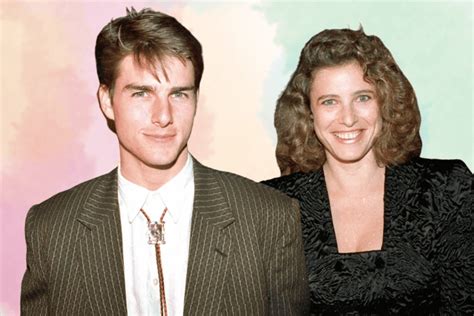
Tom Cruise’s dedication to Scientology and its emphasis on “purity” is reported to have played a significant role in the breakdown of his first marriage to actress Mimi Rogers, according to sources close to the couple at the time. Rogers, who introduced Cruise to Scientology, reportedly grew disillusioned with the church, and Cruise’s unwavering commitment ultimately led to their divorce in 1990.
Sources speaking to various outlets over the years have painted a picture of a marriage strained by the intensifying influence of Scientology on Cruise’s life. Rogers, six years older than Cruise, initially brought him into the world of Scientology in the mid-1980s. However, as Cruise ascended within the church, differences in their beliefs and priorities allegedly emerged, leading to irreconcilable issues.
According to reports, a central point of contention was Scientology’s focus on maintaining a state of “purity,” which encompassed various aspects of life, including relationships and sexuality. Some insiders have suggested that Cruise’s dedication to achieving this perceived purity within the church contributed to the marital discord.
Details surrounding the split have remained largely private over the years, with both Cruise and Rogers maintaining a discreet silence on the matter. However, occasional insights from sources close to the former couple have shed light on the complex dynamic that led to their separation.
Rogers once quipped in an interview that Cruise was “thinking of becoming a monk” during their marriage, a statement often interpreted as a veiled reference to his increasingly strict adherence to Scientology’s principles.
The divorce was finalized in 1990, marking the end of Cruise’s first foray into marriage. He went on to marry Nicole Kidman later that same year, a union that also eventually dissolved, with Scientology again cited as a potential contributing factor.
The Church of Scientology has consistently denied allegations that it interferes in the personal lives of its members or dictates their relationship choices. However, the narrative surrounding Cruise’s marriages has fueled ongoing speculation about the extent of the church’s influence.
The legacy of Cruise and Rogers’ relationship continues to generate interest, offering a glimpse into the early stages of Cruise’s involvement with Scientology and the potential challenges it posed for his personal life. The story serves as a reminder of the complex interplay between personal beliefs, relationships, and the pervasive influence of institutions like the Church of Scientology.
Further Details and Context
The marriage of Tom Cruise and Mimi Rogers, which lasted from 1987 to 1990, stands as a pivotal moment in understanding the trajectory of Cruise’s life, particularly his deep entanglement with the Church of Scientology. While the couple initially appeared well-suited, with Rogers introducing Cruise to the controversial religion, the relationship ultimately succumbed to the growing influence of Scientology on Cruise, and Rogers’ eventual disaffection with the organization.
Mimi Rogers, an established actress in her own right, was instrumental in guiding Cruise toward Scientology in the mid-1980s. At the time, Cruise was a rising star, known for his roles in films like “Risky Business” and “Top Gun,” and was seemingly open to exploring new spiritual and philosophical avenues. Rogers, already a member of the Church, saw the potential benefits that Scientology could offer Cruise, both personally and professionally.
The initial introduction to Scientology was reportedly positive, with Cruise embracing the church’s teachings and engaging in auditing sessions, a central practice within Scientology that involves intensive counseling and self-reflection. He quickly ascended within the church’s hierarchy, becoming a devoted and vocal advocate for its principles.
However, as Cruise’s commitment to Scientology deepened, a divergence began to emerge between him and Rogers. Rogers, who had been involved with Scientology for a longer period, reportedly grew disillusioned with certain aspects of the church and its practices. This divergence in beliefs created a rift within the marriage, as Cruise became increasingly entrenched in Scientology while Rogers questioned its validity.
One of the key points of contention was Scientology’s emphasis on “purity.” In Scientology, the concept of purity extends beyond moral conduct and encompasses a broader range of practices and beliefs aimed at achieving a state of spiritual and mental clarity. This can involve adhering to strict codes of conduct, undergoing regular auditing sessions, and avoiding contact with individuals deemed “suppressive persons,” or those critical of Scientology.
Sources close to the couple have suggested that Cruise’s dedication to achieving this perceived purity within the church placed a significant strain on his marriage to Rogers. The rigorous demands of Scientology, coupled with Cruise’s unwavering commitment, created an environment where Rogers felt increasingly alienated and unable to reconcile her own beliefs with those of her husband.
Adding to the strain was the significant age difference between Cruise and Rogers. Rogers, six years older than Cruise, had already established herself in Hollywood and possessed a level of maturity and experience that Cruise was still developing. As Cruise became more deeply involved with Scientology, the age gap became more pronounced, further exacerbating the differences in their perspectives and priorities.
Despite their initial compatibility and mutual affection, the marriage ultimately proved unsustainable. In 1990, just three years after tying the knot, Cruise and Rogers announced their separation, citing irreconcilable differences. The divorce was finalized shortly thereafter, marking the end of a brief but significant chapter in both of their lives.
Following the divorce, both Cruise and Rogers remained relatively tight-lipped about the specific reasons for their split. However, occasional insights from sources close to the former couple have shed light on the complex dynamic that led to their separation. Rogers once quipped in an interview that Cruise was “thinking of becoming a monk” during their marriage, a statement often interpreted as a veiled reference to his increasingly strict adherence to Scientology’s principles.
While the Church of Scientology has consistently denied allegations that it interferes in the personal lives of its members or dictates their relationship choices, the narrative surrounding Cruise and Rogers’ marriage has fueled ongoing speculation about the extent of the church’s influence. Critics of Scientology have pointed to Cruise’s subsequent marriages, both of which ended in divorce, as further evidence of the church’s alleged control over his personal life.
Cruise went on to marry actress Nicole Kidman later in 1990, a union that lasted for over a decade and produced two children. However, that marriage also eventually dissolved, with Scientology again cited as a potential contributing factor. Kidman, who was initially supportive of Cruise’s involvement with Scientology, reportedly grew increasingly uncomfortable with the church’s practices and influence.
After his divorce from Kidman in 2001, Cruise married actress Katie Holmes in 2006. This marriage also ended in divorce in 2012, with reports suggesting that Holmes filed for divorce in part to protect their daughter, Suri, from the potential influence of Scientology.
Throughout his career, Cruise has remained a steadfast and vocal advocate for Scientology, defending the church against its critics and promoting its teachings to the world. His unwavering commitment to Scientology has made him one of the most high-profile and influential members of the church, and his personal life has become inextricably linked to the organization.
The story of Cruise and Rogers’ marriage serves as a cautionary tale about the potential challenges of navigating personal relationships within the context of deeply held religious or philosophical beliefs. It highlights the importance of open communication, mutual respect, and a willingness to compromise in order to maintain a healthy and fulfilling relationship.
The legacy of Cruise and Rogers’ relationship continues to generate interest, offering a glimpse into the early stages of Cruise’s involvement with Scientology and the potential challenges it posed for his personal life. The story serves as a reminder of the complex interplay between personal beliefs, relationships, and the pervasive influence of institutions like the Church of Scientology. While the exact details of their split may never be fully known, the narrative surrounding their marriage remains a significant part of Cruise’s public persona and the ongoing debate about Scientology’s impact on its members’ lives.
The “purity” aspect, as highlighted in various reports, points to a core tenet within Scientology. It isn’t simply about sexual abstinence or traditional notions of moral cleanliness; it encompasses a holistic approach to eliminating perceived “engrams” or negative experiences from one’s past. This process, often involving intensive auditing, is believed to lead to a higher state of being and enhanced spiritual awareness. For Cruise, a rising star seeking to maximize his potential, this pursuit of “purity” likely became a central focus, potentially overshadowing the needs and desires of his then-wife, Mimi Rogers. The clash between Rogers’ evolving perspectives on Scientology and Cruise’s deepening commitment created an environment ripe for conflict, ultimately contributing to the dissolution of their marriage.
The story also underscores the power dynamics that can emerge within relationships when one partner becomes deeply entrenched in a particular ideology or belief system. In the case of Cruise and Rogers, Scientology created a framework that subtly but significantly altered their roles and priorities. Cruise’s ascent within the church likely afforded him a sense of purpose and belonging, while Rogers, growing disillusioned, may have felt increasingly marginalized and excluded. This imbalance of power can erode the foundation of any relationship, leading to resentment, misunderstanding, and ultimately, separation.
Moreover, the intense scrutiny that Cruise faced as a public figure undoubtedly amplified the pressures on his marriage. His every move was analyzed and dissected by the media, and his relationship with Rogers was constantly under the spotlight. This level of attention can be incredibly challenging for any couple, but it is particularly difficult when one partner is grappling with complex personal beliefs and the other is questioning those beliefs. The added pressure of public scrutiny likely exacerbated the existing tensions between Cruise and Rogers, making it even harder for them to navigate their differences and maintain a healthy relationship.
In conclusion, the narrative surrounding Tom Cruise and Mimi Rogers’ divorce is a multifaceted story that delves into the complexities of personal beliefs, power dynamics, and the pressures of fame. While the exact reasons for their split may never be fully known, the evidence suggests that Scientology played a significant role in shaping their relationship and ultimately contributing to its demise. The story serves as a reminder of the importance of open communication, mutual respect, and a willingness to compromise in any relationship, particularly when navigating the challenges of deeply held beliefs and the intense scrutiny of public life.
Frequently Asked Questions (FAQ)
1. What was the main reason cited for Tom Cruise and Mimi Rogers’ divorce?
Sources suggest that Cruise’s growing dedication to Scientology and its emphasis on “purity” clashed with Rogers’ evolving views on the church, leading to irreconcilable differences.
2. How did Mimi Rogers introduce Tom Cruise to Scientology?
Rogers, who was already a member of the Church of Scientology, introduced Cruise to the organization in the mid-1980s.
3. What does Scientology’s concept of “purity” entail?
In Scientology, “purity” encompasses various aspects of life aimed at achieving a state of spiritual and mental clarity. This includes adhering to strict codes of conduct, undergoing regular auditing sessions, and avoiding contact with individuals deemed “suppressive persons.”
4. Has the Church of Scientology commented on the reasons for Cruise and Rogers’ divorce?
The Church of Scientology has consistently denied allegations that it interferes in the personal lives of its members or dictates their relationship choices.
5. Did Tom Cruise’s subsequent marriages also face similar challenges related to Scientology?
Reports suggest that Scientology played a role in the dissolution of Cruise’s marriages to Nicole Kidman and Katie Holmes, with both women reportedly growing uncomfortable with the church’s practices and influence.
Expanding on the ‘Purity’ Beliefs
The concept of “purity” within Scientology is not just a superficial notion but rather a fundamental element of the church’s cosmology and practices. It’s intertwined with the belief that humans are inherently good but have been corrupted by traumatic experiences, known as “engrams,” accumulated throughout their lifetimes. These engrams are believed to cloud one’s perception of reality and hinder their spiritual progress. The goal of Scientology is to clear these engrams through a process called “auditing,” thereby restoring the individual to their original state of “purity.”
This pursuit of purity extends to various aspects of life, including relationships, sexuality, and even diet. Scientologists are often encouraged to maintain a lifestyle that minimizes exposure to negative influences and promotes mental and physical well-being. This can involve adhering to specific dietary guidelines, avoiding certain types of entertainment, and surrounding oneself with supportive and like-minded individuals.
In the context of Cruise and Rogers’ marriage, it’s plausible that Cruise’s dedication to achieving this state of purity placed a significant strain on their relationship. Rogers, perhaps less invested in the stringent requirements of Scientology, may have found it difficult to reconcile her own desires and preferences with Cruise’s increasingly rigid adherence to the church’s principles.
The emphasis on purity can also create a sense of exclusivity and separation from the outside world. Scientologists are often encouraged to associate primarily with other members of the church, which can lead to a sense of isolation from friends and family who are not involved. This can be particularly challenging for individuals in mixed-faith marriages, where one partner is deeply committed to Scientology and the other is not.
The Church of Scientology has often been criticized for its perceived control over its members’ lives, and the emphasis on purity is often cited as evidence of this control. Critics argue that the church uses the concept of purity to manipulate and isolate its members, making them more dependent on the organization and less likely to question its teachings.
The Role of Age and Experience
The age difference between Cruise and Rogers, while not vast, likely played a role in the dynamics of their marriage. Rogers, being six years older, had already established herself in Hollywood and possessed a level of maturity and experience that Cruise was still developing. This difference in life stages could have contributed to a disparity in their perspectives and priorities, making it more difficult for them to connect on a deep level.
As Cruise became more deeply involved with Scientology, the age gap may have become even more pronounced. Scientology often provides its members with a sense of purpose and belonging, which can be particularly appealing to younger individuals who are still searching for their place in the world. Cruise’s rapid ascent within the church may have further widened the gap between him and Rogers, as he embraced a new identity and worldview that she found increasingly alienating.
The difference in their levels of experience could also have contributed to the power imbalance within the marriage. Rogers, as an established actress, may have initially held a position of influence in the relationship. However, as Cruise’s star rose and he became more deeply involved with Scientology, the power dynamics likely shifted, with Cruise gaining increasing influence and control.
The Impact of Public Scrutiny
The intense scrutiny that Cruise faced as a public figure undoubtedly amplified the pressures on his marriage to Rogers. Their relationship was constantly under the spotlight, and every aspect of their lives was analyzed and dissected by the media. This level of attention can be incredibly challenging for any couple, but it is particularly difficult when one partner is grappling with complex personal beliefs and the other is questioning those beliefs.
The constant media attention may have made it more difficult for Cruise and Rogers to communicate openly and honestly with each other. They may have felt pressured to present a united front to the public, even when they were struggling with internal conflicts. The fear of negative publicity could have also made them reluctant to seek professional help or confide in friends and family.
The pressures of fame can also exacerbate existing insecurities and vulnerabilities. Cruise, as a rising star, may have been particularly susceptible to the pressures of maintaining a perfect image and pleasing his fans. This could have led him to become even more deeply entrenched in Scientology, as he sought to find stability and validation in a world that was constantly changing.
Scientology’s Influence on Subsequent Marriages
The narrative surrounding Cruise’s marriages to Nicole Kidman and Katie Holmes has also been heavily influenced by speculation about Scientology’s role. While the exact details of those relationships remain largely private, reports suggest that Scientology played a significant part in their eventual dissolution.
Kidman, who was initially supportive of Cruise’s involvement with Scientology, reportedly grew increasingly uncomfortable with the church’s practices and influence. Some reports suggest that she was pressured to distance herself from her family and friends who were critical of Scientology, and that she was subjected to invasive auditing sessions.
Holmes’ decision to file for divorce from Cruise in 2012 reportedly stemmed from her desire to protect their daughter, Suri, from the potential influence of Scientology. Holmes allegedly feared that Cruise would attempt to indoctrinate Suri into the church, and she sought to shield her from what she perceived as a harmful environment.
These accounts, while largely based on anecdotal evidence and media reports, have fueled ongoing debate about the extent of Scientology’s influence on its members’ personal lives. Critics argue that the church exerts undue control over its members, dictating their relationships, career choices, and even their parenting decisions.
Conclusion
The story of Tom Cruise and Mimi Rogers’ marriage serves as a complex and cautionary tale about the challenges of navigating personal relationships within the context of deeply held religious or philosophical beliefs. While the exact reasons for their split may never be fully known, the evidence suggests that Scientology played a significant role in shaping their relationship and ultimately contributing to its demise.
The emphasis on “purity” within Scientology, the age difference between Cruise and Rogers, the intense scrutiny of public life, and the potential influence of Scientology on Cruise’s subsequent marriages all contributed to the narrative surrounding their divorce. The story serves as a reminder of the importance of open communication, mutual respect, and a willingness to compromise in any relationship, particularly when navigating the challenges of deeply held beliefs and the intense scrutiny of public life. It also highlights the potential dangers of allowing any organization, religious or otherwise, to exert undue control over one’s personal life and relationships.









